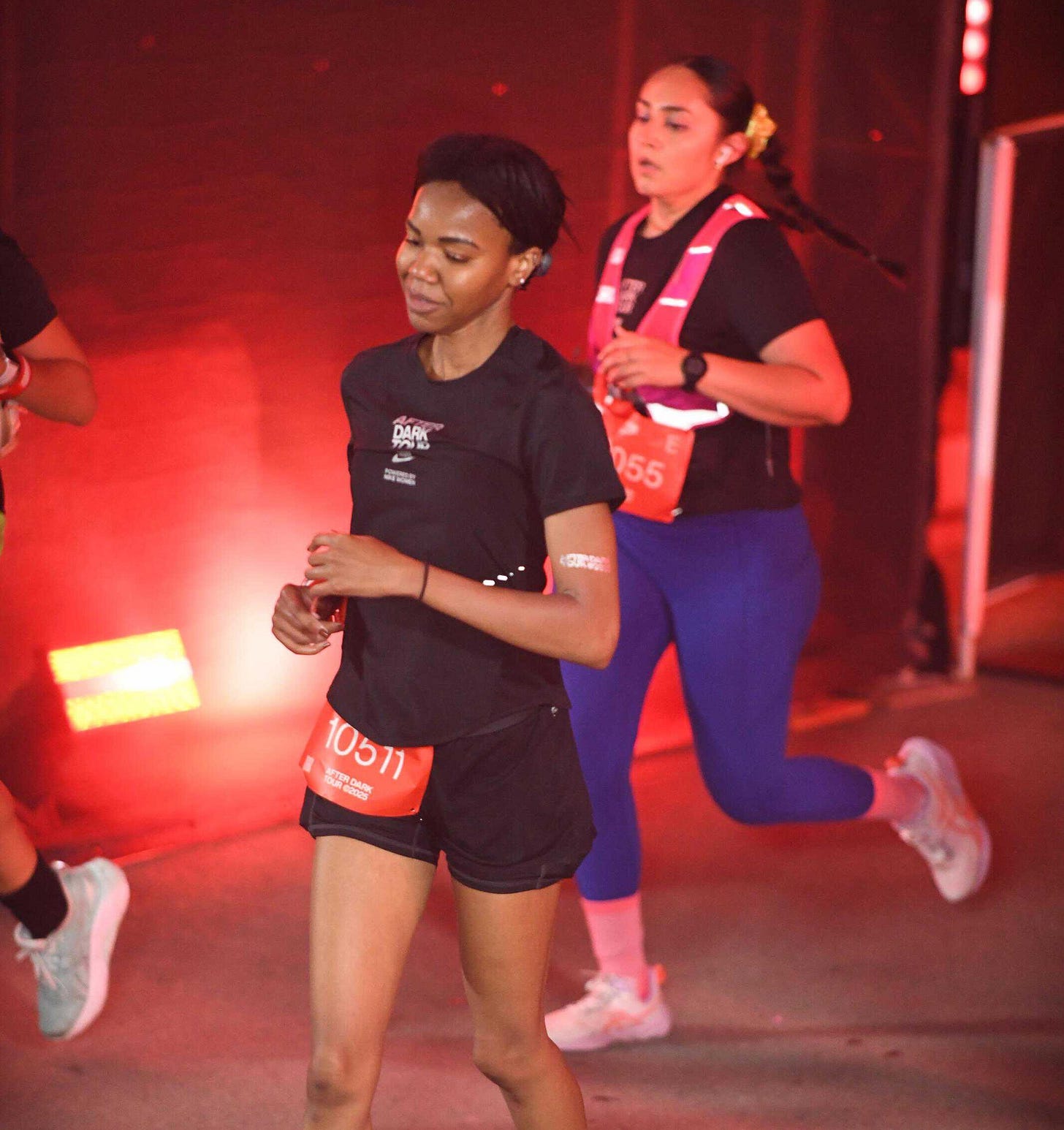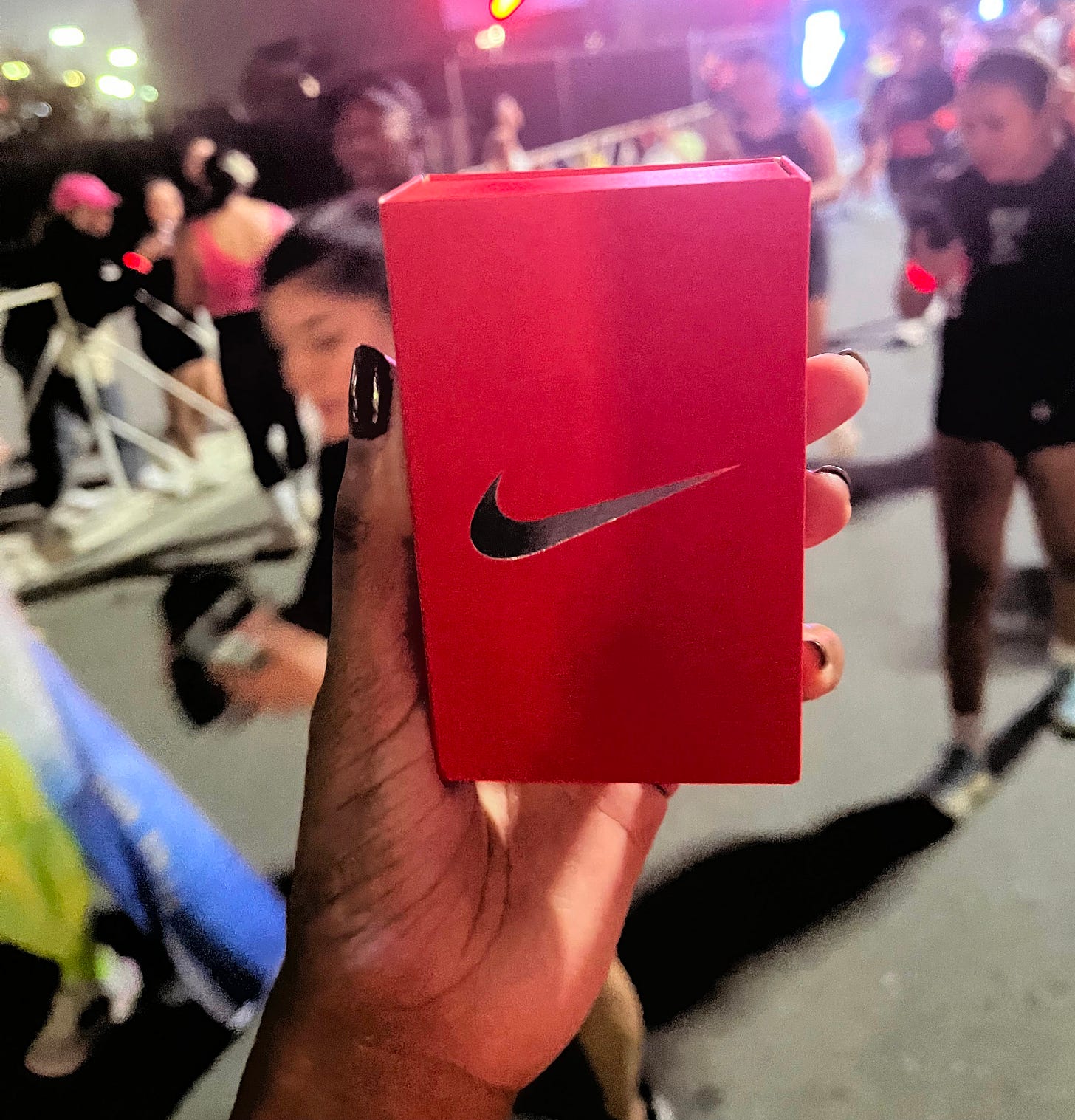Hi friends!
I used to think healing was a finish line. That once the pain stopped, I’d be “back to normal.” But what no one tells you is: an injury changes you—permanently.
Not just your body, but your mind. Your rhythms. Your confidence. Your sense of identity.
You stop trusting your strength the way you used to. You move with more hesitation, more calculation. You become hyperaware of every ache and twinge, and you constantly wonder: “Am I pushing too hard? Or not enough?” You stop measuring progress in distance or speed. Instead, your progress becomes learning how to listen to your body instead of overriding it.
And after a long road of rebuilding—mentally, physically, emotionally—I crossed the finish line at the Nike After Dark Tour Half Marathon on June 7th. And I did it without stopping once.
It was my first half marathon ever. But more than that—it was my first time trusting my body again.
The Race
Let’s start with the good stuff: it. was. a PARTY.
Nike showed out. Every mile had something new—DJs, marching bands, cheerleaders in full uniform with pom-poms. The energy on course was electric. I’ve never felt more supported or hyped during a race.
But I’d be lying if I said it wasn’t hard.
Mile 1 felt light. But by Mile 2, I was already questioning everything. “How is this already hard? I just started.” Then something shifted around Mile 3 or 4. Before I hit the turnaround point, I saw the fast runners already heading back to the finish line. That’s when I mentally checked out—on purpose. I started playing a game, scanning the runners to spot familiar faces. I dissociated to distract myself from the pain, and somehow… I looked up and I was at Mile 6.
That’s when it hit me: I haven’t stopped once. Not for a walk break. Not even to stretch.
We ran under a bridge lit up with red lights and floating bubbles while a DJ played—it all looked so magical! I could feel tears welling up. I was halfway there. Women around me were saying, “Only a 10k left, we got this.” And I believed them.
I took everything the fueling stations offered—water, energy gummies, gels. I never touched the snacks I packed. I just decided to trust that if it was being offered, it meant my body probably needed it now. I remembered how hard it was to run a 10k last year and realized how much stronger I am now.
By the time I hit Mile 10, I was floored. Ten miles with no walk breaks. Just me, my legs, and every little voice in my head saying, “You’re still running.”
After that? I dissociated again—visualizing myself in Prospect Park, where I did most of my training. Suddenly, we were at Mile 11. Then Mile 12.
That last mile felt like it would never end. The crowd chanted, “When I say ONE, you say DONE!” and I had to laugh. Nike even tricked us with five fake finish lines before the real one finally appeared.
Before I crossed it, in full sprint, I yelled, “WHERE the F*ck is the finish line?!” But I made it.
The Training
This race was never about speed. It was about trust—rebuilding it with my body after tearing my hamstring last year.
I stopped running for two months after the injury. Did a few short runs here and there, but the pain wouldn’t go away. I switched to yoga, strength training, and physical therapy. But it still wasn’t enough. So I took matters into my own hands.
I started studying sports medicine—and nine weeks later, I became a NASM-Certified Personal Trainer and Corrective Exercise Specialist at the end of 2024. Through that, I finally understood what was happening in my body and why traditional PT wasn’t cutting it.
Years of living with rheumatoid arthritis had created massive imbalances. My left side? Underactive and lengthened. My right side? Overactive and tight. It was no wonder my running form was off and injuries kept happening.
So I wrote my own corrective exercise program. I learned how to foam roll, release tension, strengthen specific weak points, and address imbalances one by one.
I also learned this: you don’t just go back to running after an injury—you rebuild your body to be able to run again.
For this half-marathon, I didn’t follow Nike’s training plan to a tee. I used it as a loose framework. I walked 3 to 4 laps around Prospect Park every week. All of my runs—including my long runs—were done on the treadmill to protect my joints. And after each one, I walked those same 3.36 miles again.
That was my secret weapon: the walking. It trained my mental toughness and taught me that even when I think I’m out of gas—I still have more to give.
The Finish
Crossing that finish line wasn’t just a physical victory. It was emotional. It was symbolic. It was me telling myself: You came back. You did it differently. And you did it right.
Some days, I still feel guilty that I didn’t run “more” during training. But finishing 13.1 miles pain-free, after everything I’ve been through?
That’s the win.
Thanks for being here and cheering me on every step of the way. I can’t wait to share what’s next.
Until next time,
C
MONTHLY UPDATES TO SHARE
🏅 Currently Training For:
This fall, I’ll be running the Marine Corps Marathon on October 26th with a complimentary bib from the Multiple Myeloma Research Foundation (MMRF)—and this one is deeply personal. I’ll be running in honor of my dad, who passed away from multiple myeloma when I was just 10 years old.
He died on Father’s Day, June 15, 2003, just days before my 5th grade graduation. It’s a story I don’t like telling, but it’s the reason this race means so much to me.
For those of you who don’t know: Multiple myeloma is a cancer that affects plasma cells (white blood cells in bone marrow which produce antibodies).
I always thought my first marathon would be the NYC Marathon, and I hoped I’d run it for him. But the Universe had other plans—and honestly, I’m grateful. The Marine Corps Marathon is known as “The People’s Marathon” and “The Marathon for Beginners,” which feels like the perfect place to start this next chapter.
If you’d like to support my fundraising efforts for MMRF, it would mean the world.
“The most common way people give up their power is by thinking they don't have any.”
- Alice Walker
The Not-So-Great Parts of the Nike After Dark Tour
As incredible as the Nike After Dark Tour Half Marathon was, there were some parts that didn’t sit right with me—and if you’ve been following conversations online, you might’ve heard about this already.
Nike quietly changed the course cut-off time after thousands of women had already registered and paid. The update wasn’t widely announced until it was too late to make an informed decision. This disproportionately impacted “back of the pack” runners—many of whom train just as hard and often face the greatest barriers when it comes to accessibility in fitness. Runners pacing around 13–15 minutes per mile were suddenly faced with a heartbreaking choice: cut their race short and complete only 9 miles, or risk being pulled off the course entirely.
Many of them were. I saw runners being escorted off the route by the LAPD and told they couldn’t continue. It was devastating.
To make matters worse, not everyone received a finisher’s medal (which, for this race, was a beautifully designed Nike Swoosh necklace). Some runners didn’t get to see the post-race concert either. From what I heard, many people just one or two waves behind me only got to hear a single song from Doechii’s set—even though they were well within their race pacing.
It’s hard not to question the fairness of it all, especially considering the 80 men who ran the race. If any of them received medals while some women didn’t—it sends the wrong message, especially at an event designed for and about women.
Oh—and whoever designed the route to include a brutal staircase climb to the stadium post-race? That was just cruel. My legs were done.
If you ran it too, I’d love to hear your experience. Also, congratulations!
Thank You, Magna 🧃✨
My new favorite magnesium + electrolyte drink —and now, one of my official partners!
🔬 What Makes Magna Different?
⚡️ Triple Magnesium Blend
Three science-backed forms of magnesium for better focus, recovery, and energy.
💧 Balanced Electrolytes
Just the right amounts of sodium and potassium—no salt bombs, no bloat. Plus Vitamin D, B6, and B12 for added performance.
🍭 Zero Sugar
Clean ingredients. No crash. No bloating.
🏅 Science + Athlete-Approved
Formulated with top doctors and pro-athletes. Third-party tested and NSF Certified for Sport.
Ready to Feel the Difference?
💻 Use my code COURTLYN for 15% off at DrinkMagna.com.
👯♀️ Or head to: Community.DrinkMagna.com/COURTLYN
Your hydration game = officially upgraded.
Until Next Time 💫
Thank you so much for reading. If this resonated with you, feel free to hit that subscribe button, tap the heart, or even share it with a friend who might need it. I’ll be back next month with more updates, insights, and all the behind-the-scenes as I continue this journey of becoming.
Let’s stay connected in the meantime:
🌐 Website — courtlynjones.com
📲 Instagram — @courtlynjones










